QUIZ 5 respiratory med surg class PDF

| Title | QUIZ 5 respiratory med surg class |
|---|---|
| Author | Erin Harris |
| Course | Fundamentals for nursing |
| Institution | College of the Sequoias |
| Pages | 17 |
| File Size | 274.9 KB |
| File Type | |
| Total Downloads | 81 |
| Total Views | 148 |
Summary
notes for chapter 21 of timbys book med surg...
Description
Answer Key Any use or attempted use of PrepU or the content herein other than as specifically authorized within the Terms & Conditions of our licensing agreement with you—without the express prior written permission of Wolters Kluwer—is strictly prohibited and will, among other things, terminate this licensing agreement and, as result, your right to use PrepU and its content. Such unauthorized use or attempted use may also violate applicable laws, including without limitation, copyright and trademark laws. Accessing PrepU constitutes your acceptance of this end user licensing agreement.
Question 1
See full question
27s Report this Question
A nurse is caring for a client with COPD who needs teaching on pursed-lip breathing. Place the steps in order in which the nurse will instruct the client. You Selected:
“Inhale through your nose.” “Slowly count to 3.”
“Exhale slowly through pursed lips.”
“Slowly count to 7.”
Correct response:
“Inhale through your nose.” “Slowly count to 3.”
“Exhale slowly through pursed lips.”
“Slowly count to 7.”
Explanation: Reference:
Timby, B.K., & Smith, N.E., Introductory Medical-Surgical Nursing, 12th ed., Philadelphia, Wolters Kluwer, 2018, Chapter 19: Introduction to the Respiratory System, p. 310. Chapter 19: Introduction to the Respiratory System - Page 310
Add a Note Bookmark this Question What's this?
Question 2
See full question
24s Report this Question
The clinic nurse is caring for a client who has been diagnosed with emphysema and who has just had a pulmonary function test (PFT) ordered. The client asks, “What exactly is this test for?” What would be the nurse’s best response? You Selected:
“A PFT measures how much air moves in and out of your lungs when you breathe.”
Correct response:
“A PFT measures how much air moves in and out of your lungs when you breathe.”
Explanation: Reference:
Timby, B.K., & Smith, N.E., Introductory Medical-Surgical Nursing, 12th ed., Philadelphia, Wolters Kluwer, 2018, Chapter 19: Introduction to the Respiratory System, Pulmonary Function Studies, pp. 289-290.
Chapter 19: Introduction to the Respiratory System - Page 289-290 Add a Note Bookmark this Question What's this?
Question 3
See full question
43s Report this Question
The nurse should convey which information to a client prior to a pulmonary function test? Select all that apply. You Selected:
The client should wear loose-fitting clothing. The client should not eat 2 hours prior to the test.
The client may be tired after the test.
Correct response:
The client should not eat 2 hours prior to the test. The client should wear loose-fitting clothing.
The client may be tired after the test.
Explanation: Reference:
Timby, B.K., & Smith, N.E. Introductory Medical-Surgical Nursing, 12th ed., Philadelphia: Wolters Kluwer Health/Lippincott Williams & Wilkins, 2018, Chapter 19: Introduction to the Respiratory System, p. 289.
Chapter 19: Introduction to the Respiratory System - Page 289 Add a Note Bookmark this Question What's this?
Question 4
See full question
19s Report this Question
A nurse is preparing a client for bronchoscopy. Which instruction should the nurse give to the client? You Selected:
Do not eat or drink for 6 hours before the procedure.
Correct response:
Do not eat or drink for 6 hours before the procedure.
Explanation: Reference:
Timby, B.K., & Smith, N.E., Introductory Medical-Surgical Nursing, 12th ed., Philadelphia, Wolters Kluwer, 2018, Chapter 19: Introduction to the Respiratory System, Nursing Care Plan 19-1, p. 292.
Chapter 19: Introduction to the Respiratory System - Page 292 Add a Note Bookmark this Question What's this?
Question 5 29s
See full question
Report this Question
The nurse is admitting a client who just had a bronchoscopy. Which assessment should be the nurse's priority? You Selected:
Swallow reflex
Correct response:
Swallow reflex
Explanation: Reference:
Timby, B.K., & Smith, N.E., Introductory Medical-Surgical Nursing, 12th ed., Philadelphia, Wolters Kluwer, 2018, Chapter 19: Introduction to the Respiratory System, Bronchoscopy, p. 291.
Chapter 19: Introduction to the Respiratory System - Page 291 Add a Note Bookmark this Question What's this?
Question 6
See full question
37s Report this Question
In which position should the client be placed for a thoracentesis? You Selected:
Sitting on the edge of the bed
Correct response:
Sitting on the edge of the bed
Explanation: Reference:
Timby, B.K., & Smith, N.E., Introductory Medical-Surgical Nursing, 12th ed., Philadelphia, Wolters Kluwer, 2018, Chapter 19: Introduction to the Respiratory System, p. 293. Chapter 19: Introduction to the Respiratory System - Page 293
Add a Note
Bookmark this Question What's this?
Question 7
See full question
20s Report this Question
A nurse is educating a client in anticipation of a procedure that will require a watersealed chest drainage system. What should the nurse tell the client and the family that this drainage system is used for? You Selected:
Removing excess air and fluid
Correct response:
Removing excess air and fluid
Explanation: Reference:
Timby, B.K., & Smith, N.E., Introductory Medical-Surgical Nursing, 12th ed., Philadelphia, Wolters Kluwer, 2018, Chapter 19: Introduction to the Respiratory System, Postoperative Nursing Management, pp. 355-356. Chapter 19: Introduction to the Respiratory System - Page 355-356
Add a Note Bookmark this Question What's this?
Question 8
See full question
3m 41s Report this Question
A nurse is suctioning the client with a tracheostomy. Place in the correct order the steps will follow to deliver care. You Selected:
Place client in Fowler’s position. Preoxygenate client for at least 1 to 2 minutes, checking that suction pressure is low.
Open the suction kit, don gloves, and lubricate a sterile, 10- to 14- French disposable catheter with sterile saline.
Insert catheter into the lumen of the tube.
Begin intermittent suctioning while slowly withdrawing and rotating the catheter.
Discard the suction catheter after use.
Correct response:
Place client in Fowler’s position. Preoxygenate client for at least 1 to 2 minutes, checking that suction pressure is low.
Open the suction kit, don gloves, and lubricate a sterile, 10- to 14- French disposable catheter with sterile saline.
Insert catheter into the lumen of the tube.
Begin intermittent suctioning while slowly withdrawing and rotating the catheter.
Discard the suction catheter after use.
Explanation: Reference:
Timby, B.K., & Smith, N.E., Introductory Medical-Surgical Nursing, 12th ed., Philadelphia, Wolters Kluwer, 2018, Chapter 20: Caring for Clients with Upper Respiratory Disorders, p. 313.
Chapter 20: Caring for Clients with Upper Respiratory Disorders - Page 313 Add a Note Bookmark this Question What's this?
Question 9
See full question
25s Report this Question
The nurse is taking a respiratory history for a patient who has come into the clinic with a chronic cough. What information should the nurse obtain from this patient? (Select all that apply.) You Selected:
Previous history of lung disease in the patient or family Previous history of smoking
Occupational and environmental influences
Correct response:
Previous history of lung disease in the patient or family Occupational and environmental influences
Previous history of smoking
Explanation: Reference:
Timby, B.K., & Smith, N.E., Introductory Medical-Surgical Nursing, 12th ed., Philadelphia, Wolters Kluwer, 2018, Chapter 19: Introduction to the Respiratory System, History, p. 287.
Chapter 19: Introduction to the Respiratory System - Page 287 Add a Note Bookmark this Question What's this?
Question 10
See full question
14s Report this Question
A client is brought to the ED by ambulance after a motor vehicle accident in which the client received blunt trauma to the chest. The client is in acute respiratory failure, is intubated, and is transferred to the ICU. What assessment parameters should the nurse monitor most closely? Select all that apply. You Selected:
Vital signs Level of consciousness
Arterial blood gases
Correct response:
Level of consciousness Arterial blood gases
Vital signs
Explanation: Reference:
Timby, B.K., & Smith, N.E., Introductory Medical-Surgical Nursing, 12th ed., Philadelphia, Wolters Kluwer, 2018, Chapter 21: Caring for Clients with Lower Respiratory Disorders, Nursing Management, p. 348. Chapter 21: Caring for Clients with Lower Respiratory Disorders - Page 348
Add a Note Bookmark this Question What's this?
Question 11
See full question
7s Report this Question
What are the primary functions of the lungs? Select all that apply. You Selected:
gas exchange ventilation
Correct response:
ventilation gas exchange
Explanation: Reference:
Timby, B.K., & Smith, N.E. Introductory Medical-Surgical Nursing, 12th ed., Philadelphia: Wolters Kluwer Health/Lippincott Williams & Wilkins, 2018, Chapter 19: Introduction to the Respiratory System, p. 283.
Chapter 19: Introduction to the Respiratory System - Page 283 Add a Note Bookmark this Question What's this?
Question 12
See full question
21s Report this Question
The nurse is performing a nutritional assessment on a client who has been diagnosed with cancer of the larynx. Which laboratory values would be assessed when determining the nutritional status of the client? Select all that apply. You Selected:
Glucose level Albumin level
Protein level
Correct response:
Protein level Albumin level
Glucose level
Explanation: Reference:
Timby, B.K., & Smith, N.E., Introductory Medical-Surgical Nursing, 12th ed., Philadelphia, Wolters Kluwer, 2018.
Add a Note Bookmark this Question What's this?
Question 13
See full question
58s Report this Question
Not every structure in the upper airway has a purpose in respiration. There are some structures whose role is immunological. Which structures protect against infection? Select all that apply. You Selected:
palantine tonsils pharyngeal tonsils
Correct response:
palantine tonsils pharyngeal tonsils
Explanation: Reference:
Timby, B.K., & Smith, N.E. Introductory Medical-Surgical Nursing, 12th ed., Philadelphia: Wolters Kluwer Health/Lippincott Williams & Wilkins, 2018, Chapter 19: Introduction to the Respiratory System, p. 283. Chapter 19: Introduction to the Respiratory System - Page 283
Add a Note Bookmark this Question What's this?
Question 14
See full question
24s Report this Question
Following thoracic surgery, what should the nurse include in the care plan for a client at risk for impaired gas exchange? Select all that apply. You Selected:
Elevate head of bed 30 to 40 degrees as tolerated. Monitor vital signs frequently.
Reinforce preoperative breathing exercises.
Correct response:
Monitor vital signs frequently. Reinforce preoperative breathing exercises.
Elevate head of bed 30 to 40 degrees as tolerated.
Administer pain medications.
Explanation: Reference:
Timby, B.K., & Smith, N.E. Introductory Medical-Surgical Nursing, 12th ed., Philadelphia: Wolters Kluwer Health/Lippincott Williams & Wilkins, 2018, Chapter 21: Caring for Clients with Lower Respiratory Disorders, p. 356.
Chapter 21: Caring for Clients with Lower Respiratory Disorders - Page 356 Add a Note Bookmark this Question What's this?
Question 15
See full question
11s Report this Question
A 22-year-old college student recently returned from a backpacking trip to Southeast Asia and has been experiencing increasing malaise over the past 2 weeks. Today, he is seeking care because he reports that he coughed up blood during a particularly heavy coughing fit this morning. The nurse would document the presence of: You Selected:
Hemoptysis
Correct response:
Hemoptysis
Explanation: Reference:
Timby, B.K., & Smith, N.E., Introductory Medical-Surgical Nursing, 12th ed., Philadelphia, Wolters Kluwer, 2018.
Add a Note Bookmark this Question What's this?
Question 16
See full question
1m 6s Report this Question
A client is having a pulmonary angiography. Which sign would indicate an allergic reaction to the contrast medium? You Selected:
difficulty breathing
Correct response:
difficulty breathing
Explanation: Reference:
Timby, B.K., & Smith, N.E. Introductory Medical-Surgical Nursing, 12th ed., Philadelphia: Wolters Kluwer Health/Lippincott Williams & Wilkins, 2018, Chapter 19: Introduction to the Respiratory System, p. 290.
Chapter 19: Introduction to the Respiratory System - Page 290 Add a Note Bookmark this Question What's this?
Question 17
See full question
11s Report this Question
An older male client with a history of chronic laryngitis reports a persistent hoarseness. What condition is the client at risk to develop? You Selected:
laryngeal cancer
Correct response:
laryngeal cancer
Explanation: Reference:
Timby, B.K., & Smith, N.E. Introductory Medical-Surgical Nursing, 12th ed., Philadelphia: Wolters Kluwer Health/Lippincott Williams & Wilkins, 2018, Chapter 20: Caring for Clients with Upper Respiratory Disorders, p. 308. Chapter 20: Caring for Clients with Upper Respiratory Disorders - Page 308
Add a Note Bookmark this Question What's this?
Question 18
See full question
7s Report this Question
A client is recovering in the hospital from a bout with empyema. What intervention would the nurse implement to promote healing and oxygenation? You Selected:
Encourage breathing exercises.
Correct response:
Encourage breathing exercises.
Explanation: Reference:
Timby, B.K., & Smith, N.E. Introductory Medical-Surgical Nursing, 12th ed., Philadelphia: Wolters Kluwer Health/Lippincott Williams & Wilkins, 2018, Chapter 21: Caring for Clients with Lower Respiratory Disorders, p. 325. Chapter 21: Caring for Clients with Lower Respiratory Disorders - Page 325
Add a Note
Bookmark this Question What's this?
Question 19
See full question
18s Report this Question
Which term will the nurse use to document the inability of a client to breathe easily unless positioned upright? You Selected:
Orthopnea
Correct response:
Orthopnea
Explanation: Reference:
Timby, B.K., & Smith, N.E., Introductory Medical-Surgical Nursing, 12th ed., Philadelphia, Wolters Kluwer, 2018.
Add a Note Bookmark this Question What's this?
Question 20
See full question
16s Report this Question
The nurse is caring for a client at risk for atelectasis. The nurse implements a first-line measure to prevent atelectasis development in the client. What is an example of a firstline measure to minimize atelectasis? You Selected:
Incentive spirometry
Correct response:
Incentive spirometry
Explanation: Reference:
Timby, B.K., & Smith, N.E., Introductory Medical-Surgical Nursing, 12th ed., Philadelphia, Wolters Kluwer, 2018, Chapter 21: Caring for Clients with Lower Respiratory Disorders, Nursing Management, p. 332.
Chapter 21: Caring for Clients with Lower Respiratory Disorders - Page 332 Add a Note Bookmark this Question What's this?
Question 21
See full question
15s Report this Question
A client who underwent surgery 12 hours ago has difficulty breathing. He has petechiae over his chest and complains of acute chest pain. What action should the nurse take first? You Selected:
Initiate oxygen therapy.
Correct response:
Initiate oxygen therapy.
Explanation: Reference:
Timby, B. K., Smith, N. E. Introductory Medical–Surgical Nursing , 12th ed., Philadelphia: Wolters Assessment Kluwer Health/Lippincott Williams & Wilkins, 2018, Chapter 21: Caring for Clients With Lower Respiratory Disorders , p. 347. Chapter 21: Caring for Clients with Lower Respiratory Disorders - Page 347
Add a Note Bookmark this Question What's this?
Question 22
See full question
8s Report this Question
A client hospitalized with pneumonia has thick, tenacious secretions. Which intervention should the nurse include when planning this client's care? You Selected:
Encouraging increased fluid intake
Correct response:
Encouraging increased fluid intake
Explanation: Reference:
Timby, B. K., Smith, N. E. Introductory Medical–Surgical Nursing , 12th ed., Philadelphia: Wolters Assessment Kluwer Health/Lippincott Williams & Wilkins, 2018, Chapter 21: Caring for Clients With Lower Respiratory Disorders , p. 323.
Chapter 21: Caring for Clients with Lower Respiratory Disorders - Page 323 Add a Note Bookmark this Question What's this?
Question 23
See full question
10s Report this Question
The home care nurse is planning to begin breathing retraining exercises with a client newly admitted to the home h...
Similar Free PDFs

QUIZ 5 respiratory med surg class
- 17 Pages

Med Surg I Respiratory Overview
- 25 Pages
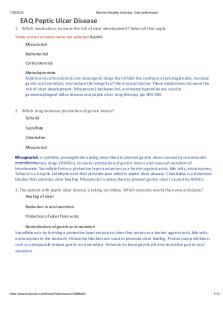
Med surg peptic ulcer quiz
- 12 Pages

Med Surg ATI Dynamic Quiz
- 3 Pages

Ati med surg quiz - ati proctor
- 4 Pages
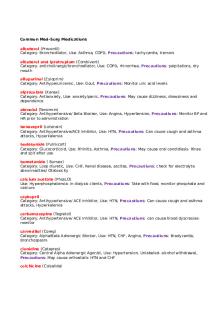
Common Med Surg Meds
- 7 Pages

Med surg dorris bowman
- 4 Pages
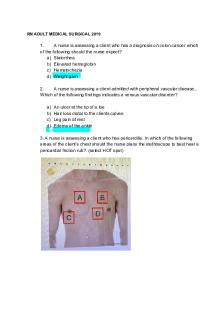
Med surg - notes
- 28 Pages
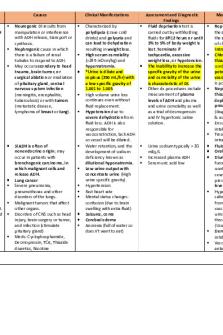
Med-Surg Endocrine
- 11 Pages
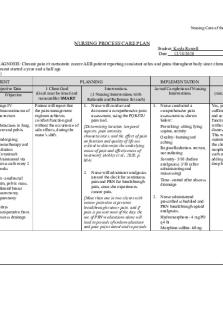
Med Surg- Care Plan
- 6 Pages
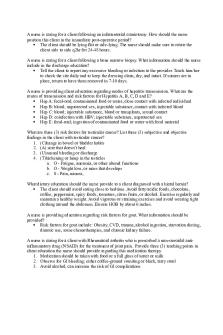
Med-Surg Capstone remediation
- 4 Pages

Med Surg Exam 3
- 19 Pages
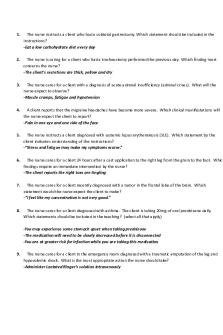
Kaplan med surg 2
- 8 Pages
Popular Institutions
- Tinajero National High School - Annex
- Politeknik Caltex Riau
- Yokohama City University
- SGT University
- University of Al-Qadisiyah
- Divine Word College of Vigan
- Techniek College Rotterdam
- Universidade de Santiago
- Universiti Teknologi MARA Cawangan Johor Kampus Pasir Gudang
- Poltekkes Kemenkes Yogyakarta
- Baguio City National High School
- Colegio san marcos
- preparatoria uno
- Centro de Bachillerato Tecnológico Industrial y de Servicios No. 107
- Dalian Maritime University
- Quang Trung Secondary School
- Colegio Tecnológico en Informática
- Corporación Regional de Educación Superior
- Grupo CEDVA
- Dar Al Uloom University
- Centro de Estudios Preuniversitarios de la Universidad Nacional de Ingeniería
- 上智大学
- Aakash International School, Nuna Majara
- San Felipe Neri Catholic School
- Kang Chiao International School - New Taipei City
- Misamis Occidental National High School
- Institución Educativa Escuela Normal Juan Ladrilleros
- Kolehiyo ng Pantukan
- Batanes State College
- Instituto Continental
- Sekolah Menengah Kejuruan Kesehatan Kaltara (Tarakan)
- Colegio de La Inmaculada Concepcion - Cebu


